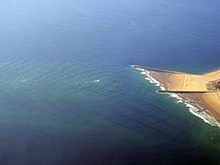

A cross sea (also referred to as a squared sea or square waves [a]) is a sea state of wind-generated ocean waves that form nonparallel wave systems. Cross seas have a large amount of directional spreading. [1] This may occur when water waves from one weather system continue despite a shift in wind. Waves generated by the new wind run at an angle to the old.
Two weather systems that are far from each other may create a cross sea when the waves from the systems meet at a place far from either weather system. Until the older waves have dissipated, they can present a perilous sea hazard. [2]
This sea state is fairly common and a large percentage of ship accidents have been found to occur in this state. [3] Vessels fare better against large waves when sailing directly perpendicular to oncoming surf. In a cross sea scenario, that becomes impossible as sailing into one set of waves necessitates sailing parallel to the other. [4]
A cross swell is generated when the wave systems are longer-period swells, rather than short-period wind-generated waves. [5]
Notes
- ^ Not to be confused with square wave, a waveform.
References
- ^ "Cross Sea". Glossary of Meteorology. American Meteorological Society. Retrieved 4 Feb 2019.
- ^ "Is the Cross Sea Dangerous?". earth.esa.int. Archived from the original on 2017-08-24. Retrieved 2020-09-07.
- ^ Toffoli, A.; Lefevre, J. M.; Bitner-Gregersen, E.; Monbaliu, J. (2005). "Towards the identification of warning criteria: Analysis of a ship accident database". Applied Ocean Research. 27 (6): 281–291. doi: 10.1016/j.apor.2006.03.003.
- ^ Xiaoming Li. "Is the Cross Sea Dangerous?". Wayback machine. Archived from the original on 2014-05-03. Retrieved 10 February 2019.
- ^ Bowditch, Nathaniel (1995). "Glossary C" (PDF). The American Practical Navigator. Bethesda, MD: National Imagery and Mapping Agency. p. 758. ISBN 0-403-09895-5. Archived from the original (PDF) on 2011-07-16. Retrieved 2007-11-29.

